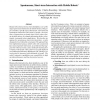Free Online Productivity Tools
i2Speak
i2Symbol
i2OCR
iTex2Img
iWeb2Print
iWeb2Shot
i2Type
iPdf2Split
iPdf2Merge
i2Bopomofo
i2Arabic
i2Style
i2Image
i2PDF
iLatex2Rtf
Sci2ools
ICRA
1999
IEEE
1999
IEEE
Spontaneous, Short-Term Interaction with Mobile Robots
Human-robot interaction has been identified as one of the major open research directions in mobile robotics. This paper considers a specific type of interaction: short-term and spontaneous interaction with crowds of people. Such patterns of interactions are found when service robots operate in public places, for example information kiosks, receptionists, tour-guide robots applications. We describe our approach to spontaneous short-term interaction: a robot designed to be a believable social agent. The approach has been implemented using a mobile robot with a motorized face as focal point for interaction, an architecture that suggests the robot has moods, and a method for learning how to interact with people. Our system was recently deployed at a Smithsonian museum in Washington, DC. During a two week period it interacted with thousands of people. The robot's interactive capabilities were essential for its high on-task performance, and thus its practical success.
| Added | 03 Aug 2010 |
| Updated | 03 Aug 2010 |
| Type | Conference |
| Year | 1999 |
| Where | ICRA |
| Authors | Jamieson Schulte, Charles R. Rosenberg, Sebastian Thrun |
Comments (0)

